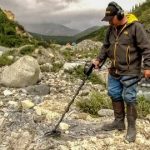Geoground gold, a hidden treasure beneath the Earth’s surface, has long been a fascination for scientists, explorers, and treasure hunters alike. This mysterious and elusive form of wealth has captivated the imagination of humanity for centuries, sparking numerous expeditions and quests for its discovery. In this article, we will delve into the world of geoground gold, uncovering its origins, properties, and potential significance in modern society. Join us as we embark on a journey to uncover the secrets of this precious hidden treasure beneath our feet.
“Uncovering the Geoground Gold: A Hidden Treasure Beneath Our Feet” is a comprehensive guide to discovering the untapped potential of geological resources. The book explores the various minerals and metals found beneath the Earth’s surface, providing valuable insights into the economic, environmental, and social implications of harnessing these resources. Through engaging narratives and informative analysis, the author sheds light on the significance of geoground exploration and the importance of sustainable resource management. Whether you are a geology enthusiast, an industry professional, or simply curious about the hidden treasures beneath our feet, this book offers a fascinating and insightful exploration of the geoground gold.
Uncovering the Hidden Treasure: The Beauty of Geoground Gold
Geoground gold, also known as “nugget gold” or “placer gold,” refers to the naturally occurring gold found in deposits within the earth’s surface. This type of gold is usually found in river beds, alluvial soils, or other sedimentary environments. Geoground gold has held great significance throughout history, as it has been a major driver of exploration, mining, and economic development. The unique geological processes that lead to the formation of geoground gold make it a fascinating area of study for geologists and mining experts alike. As we continue to learn more about the formation and extraction of geoground gold, it is important to consider both its economic potential and the environmental impact of mining operations.
The book “Uncovering the Hidden Treasure: The Beauty of Geoground Gold” provides in-depth information about the geological formation and properties of gold found within the earth’s crust. It explores the various methods of extracting gold and delves into its uses and significance throughout history. The book also discusses the environmental impact of gold mining and the contemporary challenges associated with the industry. With a focus on both scientific and cultural aspects, this book offers a comprehensive understanding of the beauty and complexity of geoground gold.
Exploring the Riches of Geoground Gold Deposits Around the World
Exploring the Riches of Geoground Gold Deposits Around the World is a comprehensive guide to understanding and tapping into the vast potential of gold deposits in various geographical locations. The book covers topics such as the formation of gold deposits, the different types of deposits, and the exploration and extraction methods used to uncover them. It also delves into the economic and environmental impacts of gold mining, making it an essential resource for professionals in the mining industry, as well as students and researchers interested in the field. With insights from experts and case studies from around the world, this book offers a thorough look at the opportunities and challenges of geoground gold deposits.
The Geological Significance of Geoground Gold and Its Formation
Geoground gold is significant in the field of geology due to its unique formation process. This type of gold is formed within the Earth’s crust, typically in areas where there is active tectonic activity. Geoground gold is often found near fault lines, where the movement of tectonic plates creates the conditions necessary for gold to be deposited.
The formation of geoground gold begins with the circulation of hot water within the Earth’s crust. This water, which is often rich in various minerals including gold, moves through fractures and faults in the rock. As the water cools, the minerals within it are deposited, including gold. Over time, these deposits can accumulate and form sizable gold veins within the rock.
Studying geoground gold can provide valuable insights into the geological history of a particular area. By understanding the conditions under which geoground gold is formed, geologists can gain a better understanding of the tectonic processes that have shaped the Earth’s crust over time.
In addition, the presence of geoground gold can also be an indicator of other valuable mineral deposits. Gold is often found in association with other metals such as copper, silver, and lead. Therefore, the study of geoground gold can also lead to the discovery of other economically significant mineral resources.
Overall, the geological significance of geoground gold lies in its role as a marker of tectonic activity and its potential as a source of valuable mineral resources. Studying the formation and distribution of geoground gold can provide important insights into the Earth’s geological processes and the potential for economic mineral deposits.
The Economic Impact of Geoground Gold Mining on Local Communities
Gold mining can have a significant economic impact on local communities. It can lead to the creation of jobs, both directly in the mining industry and indirectly in supporting industries such as construction, transportation, and retail. The presence of a gold mine can also lead to increased infrastructure development, such as roads, schools, and healthcare facilities, which can benefit the entire community.
On the other hand, gold mining can also bring negative economic impacts. It can lead to environmental degradation, which can harm sectors such as agriculture and tourism. In addition, mining can result in the displacement of local communities and the loss of traditional livelihoods.
Overall, the economic impact of gold mining on local communities is complex and multifaceted. It is important for mining companies to work closely with local stakeholders to minimize negative impacts and maximize the benefits for the community. This can include initiatives such as local hiring and procurement, community development projects, and environmental conservation efforts.
Understanding the Environmental Impact of Geoground Gold Extraction
Understanding the environmental impact of geoground gold extraction involves studying how the process affects the surrounding ecosystem, including water quality, soil stability, and wildlife habitat. This may involve monitoring water and soil pollution, assessing the disturbance of local flora and fauna, and evaluating the potential for long-term ecological damage. Additionally, researchers may also examine the carbon footprint and energy consumption associated with geoground gold extraction to understand its overall environmental impact.
The Evolution of Geoground Gold Mining Techniques Through History
The evolution of geoground gold mining techniques through history has been marked by advancements in technology and a better understanding of geological processes. From ancient civilizations using rudimentary tools to modern industrial mining operations, the methods of extracting gold from the earth have become more sophisticated and efficient.
In the early days of gold mining, prospectors would typically use simple tools such as picks, shovels, and pans to extract gold from surface deposits or riverbeds. As exploration expanded, miners began to develop more advanced techniques such as hydraulic mining, which involved using high-pressure water jets to break up gold-bearing ore.
The invention of the rock drill and explosives in the 19th century revolutionized underground mining, allowing miners to access deeper gold deposits. This was further improved with the introduction of machinery such as stamp mills and cyanide leaching, which increased the efficiency of extracting gold from ore.
In the modern era, gold mining has become highly mechanized, with large-scale open-pit and underground operations utilizing heavy machinery and advanced technology such as GPS and remote sensing to locate and extract gold deposits. Additionally, environmental and safety concerns have led to the development of more sustainable mining practices, including the use of bioleaching and other environmentally friendly extraction methods.
Overall, the evolution of geoground gold mining techniques has been driven by a combination of technological advancements, economic pressures, and a growing awareness of environmental and social responsibility. As the industry continues to evolve, it is likely that new innovations and approaches to gold mining will continue to emerge.
The Role of Geoground Gold in Shaping Earth’s Geological Landscape
Geoground gold plays a significant role in shaping the Earth’s geological landscape through its influence on the formation and stability of rock structures. As a natural mineral, geoground gold is often found in veins within the Earth’s crust, where it can exert pressure on surrounding rocks and influence their deformation. This can lead to the creation of fault lines, folds, and other geological features that contribute to the overall landscape.
Additionally, geoground gold can also serve as a catalyst for chemical reactions within the Earth’s crust, leading to the formation of new mineral deposits and the alteration of existing rock formations. This can have a profound impact on the composition and appearance of the geological landscape.
Furthermore, the presence of geoground gold can also influence erosion patterns and the formation of sedimentary deposits, leading to changes in the topography of the Earth’s surface over time. Overall, the role of geoground gold in shaping the Earth’s geological landscape is multifaceted and continues to be an area of active research and exploration in the field of geology.
Geoground Gold: A Rare and Precious Natural Resource
Geoground Gold is a rare and precious natural resource that is highly sought after for its value and beauty. It is formed deep within the earth’s crust through a combination of geological processes, including heat and pressure, over millions of years. Due to its scarcity and the extensive mining and refining processes required to extract it, geoground gold is considered one of the most valuable and luxurious metals in the world.
As a result of its unique properties and limited availability, geoground gold is often used for the production of fine jewelry, luxury goods, and high-end electronic components. Its lustrous, yellow appearance and resistance to corrosion make it a popular choice for creating timeless and enduring pieces of art and craftsmanship.
The mining and extraction of geoground gold can have significant environmental and social impacts, as it often involves extensive land disturbance and the use of hazardous chemicals. However, sustainable mining practices and responsible sourcing initiatives have been implemented to minimize these negative effects and ensure the ethical production of geoground gold.
Overall, geoground gold holds a special place in human history and culture, symbolizing wealth, power, and beauty. Its rarity and enduring appeal continue to make it a highly prized natural resource in various industries around the world.
The Intriguing Geology Behind the Formation of Geoground Gold
The formation of Geoground gold is a result of a combination of geological processes. It is formed through the concentration of gold particles in sedimentary rocks, particularly in areas where water flows and reworks the sediment. Over time, these particles accumulate and form deposits of gold-bearing material. Furthermore, the presence of certain minerals and geological structures, such as fault lines and folds, can also play a role in the formation and concentration of gold in the Geoground. Understanding these geological factors is crucial for identifying potential gold-bearing areas for exploration and mining.
The Future of Geoground Gold Mining: Challenges and Opportunities
The future of geoground gold mining presents both challenges and opportunities. As traditional gold reserves are depleted, mining companies are exploring new technologies and methods to extract gold from deeper and more complex geological formations. This presents challenges in terms of increased costs, environmental concerns, and regulatory hurdles.
On the other hand, advances in technology, such as remote sensing, geophysical imaging, and data analytics, offer new opportunities for identifying untapped gold deposits. Additionally, sustainable mining practices and social responsibility are becoming increasingly important considerations for the industry.
Overall, the future of geoground gold mining will require a balance between technological innovation, environmental stewardship, and social responsibility in order to maximize the opportunities and address the challenges.
nugget gold
Nugget gold refers to small, irregularly shaped pieces of gold found in sediment, such as rivers and streams. It is often considered to be the purest form of gold, as it has not been exposed to the same weathering and erosion as gold found in larger, more polished nuggets. Nugget gold is highly sought after by collectors and jewelry makers for its unique appearance and high gold content. It is often found by panning for gold in waterways, and can also be found in underground deposits.
placer gold,
Placer gold is a type of gold deposit that is found in river or stream beds. It is formed when gold is eroded from its original source, such as a vein or lode, and then carried by water and deposited as sediment. This type of gold deposit is often found in small flakes or nuggets and can be relatively easy to extract using simple tools such as a gold pan or sluice box. Placer mining has been a popular and lucrative activity for many gold prospectors throughout history, and continues to be a significant source of gold production today.
Geoground
Geoground is a geotechnical consulting company that specializes in providing services related to soil and rock characterization, foundation design, slope stability analysis, and other geotechnical engineering services. They work with a wide range of clients in the construction, infrastructure, and natural resource sectors to help them make informed decisions about their projects. Geoground employs a team of experienced geotechnical engineers and geologists who are dedicated to delivering high-quality and practical solutions to their clients’ unique challenges.
placers
Placers are deposits of valuable minerals or metals that have been transported and concentrated by flowing water. These deposits are typically found in rivers, stream beds, or along coastlines. Placer mining is the process of extracting these minerals from the sediment using various methods such as panning, sluicing, or dredging. Common placer minerals include gold, silver, and platinum, as well as gemstones like diamonds and sapphires. Placer deposits can be rich and extensive, making them an important source of valuable resources.
placer deposit
Placer deposits are a type of mineral deposit that consists of valuable minerals that have been transported and concentrated by gravity separation processes. These deposits are formed by the erosion of primary mineral deposits and subsequent sorting and accumulation of the valuable minerals by flowing water. Placer deposits are typically found in riverbeds, beaches, and other sedimentary environments where water flow is present. Common minerals found in placer deposits include gold, diamonds, tin, and titanium. These deposits are often exploited through the process of panning, sluicing, and dredging to extract the valuable minerals.
In conclusion, it is clear that geoground gold is a valuable and often overlooked resource that holds great potential for various industries. By uncovering the geoground gold, we can tap into a hidden treasure beneath our feet and utilize it for economic and technological advancements. It is important for us to continue researching and exploring this resource to fully understand its potential and benefits for our society. Geoground gold truly has the power to revolutionize our world in numerous ways, and it is up to us to recognize and harness its value.
See also: metal detector gold detector
See also
https://www.maisondeladetection.com/
https://www.inventumdetector.fr/
https://www.detecteurs.fr/









